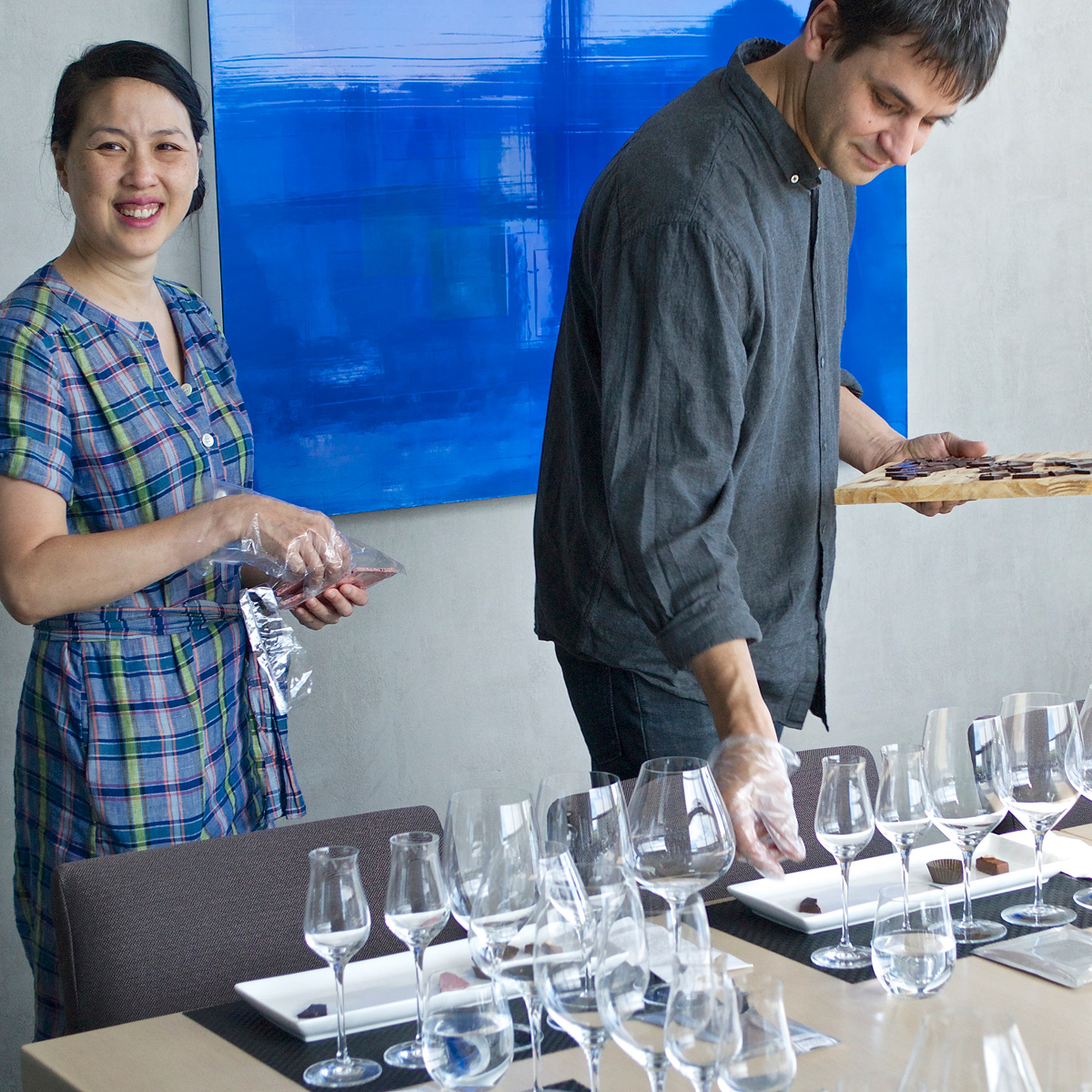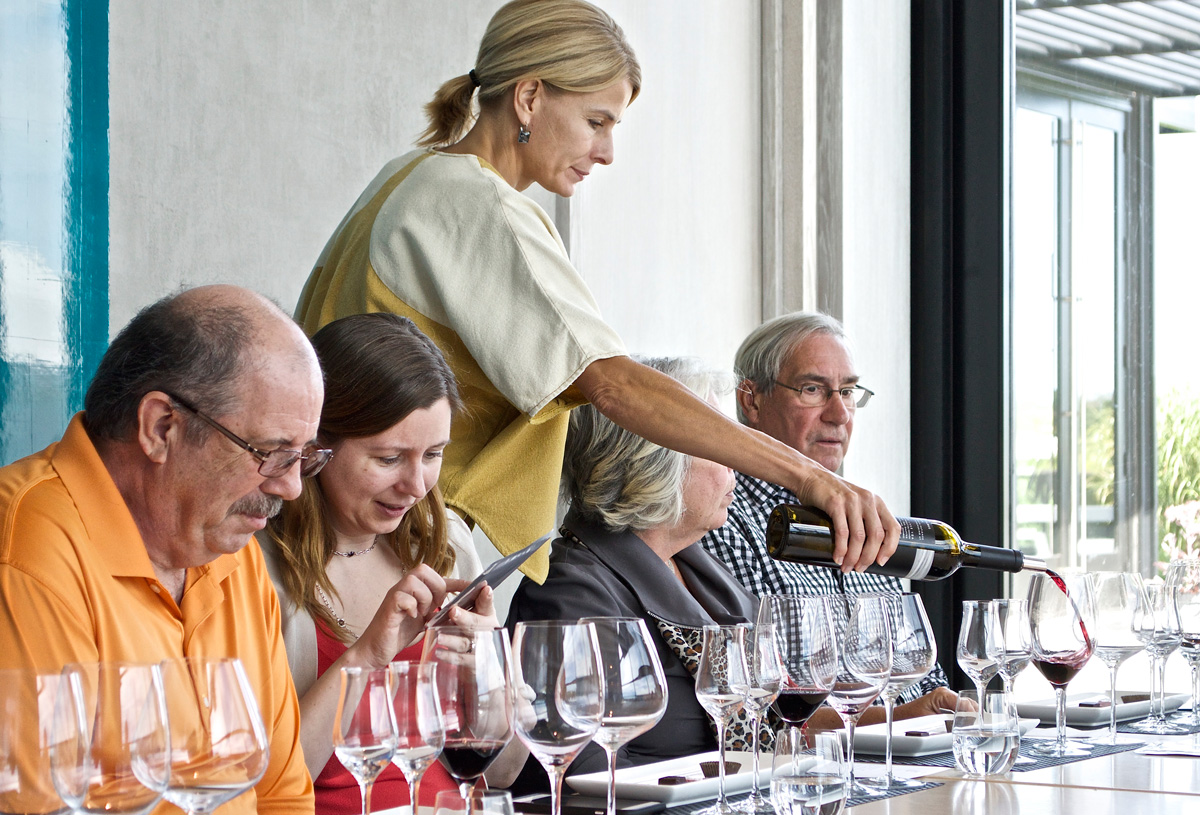
Ontario Wine Culture

Toronto-based Pluck Tea and Soma Chocolatemaker collaborate with Niagara wineries Southbrook and Stratus to turn waste from winemaking into delicious eats. Jen Chan photo.
Today’s most valuable form of alchemy isn’t transforming things into gold, it’s figuring out how to reduce, reuse and recycle in everything we do. Lately Ontario wine and food producers are playing alchemist transforming wine waste into good eats.
Throwing out grape skins has long bothered Southbrook Winery owner Bill Redelmeier. It’s a great irony given they’re largely responsible for red wine’s colour, flavour, aroma and structure. Throwing out 1/5th of every grape as wine making waste just wouldn’t do, especially after building the winery using the Gold LEED (Leadership in Energy and Environmental Design) standard and running it as Canada’s first certified biodynamic winery—organic’s more holistic mystical cousin. So he came up with Bioflavia, an organic red wine grape skin powder made from the winery’s leftover grapes, which are too acidic to compost. Biofalvia’s use as a nutritional supplement isn’t even its most innovate use.
In the nascent years of Pluck Teas, owner and tea sommelier Jennifer Commins invested in a booth at the city’s popular and influential Evergreen Brickworks farmers market hoping to make connections and transform the way we drink tea in restaurants. But she also serendipitously met Redelmeier there who was promoting Bioflavia.
With a similar philosophy of environmentalism, wellness, supporting local and ethical sourcing, Commins found a kindred spirt and hatched plans to collaborate. “When you’re doing something good in the cup, it’s 100% more delicious,” she says.
But there was one hitch, Bioflavia was too fine for her teas. So she asked Redelmeier for a pre-milled sample to experiment. It worked perfectly and Pluck Teas’ signature Southbrook Berry Blend with its deep crimson hue, fragrant berries, hibiscus, and Cabernet Franc skins, was born. It’s joined by Sunset in Niagara, Commins’ take on a rooibos tea with the Cabernet Franc skins boosting the berry taste and antioxidants.
The Ontario food and wine world have tag teamed to transform more than just waste grape skins into food gold. Fermentation is the magic step that turns mere grape juice into wine and it also happens to be what helps transform cacao into chocolate

Cynthia Leung and David Castellan of Soma Chocolatemaker setting-up for a chocolate and wine tasting at Stratus. Elena Galey-Pride photo.
With a shelf full of International Chocolate Awards Toronto’s Soma is amongst the world’s best chocolate makers. The Willy Wonkas behind the brand, owners David Castellan and Cynthia Leung are pioneers of the bean-to-bar movement and with over a decade and a half of experimentation they’ve carefully honed every step of the chocolate making process.
Lately Castellan draws inspiration from the wine world when pondering how to raise his chocolate making game. “A winemaker can just go into field and take care of his grapes. We have to depend on what happens before we get the beans and that’s the missing link―it’s far away, in South America. That’s the next bridge for us. To be involved in the fermentation,” he says.
This wine inspiration isn’t half a world away. It comes from down the QEW courtesy of an accidental collaboration with Niagara winery Stratus.
A few years ago Castellan and Leung were determined to find a way to infuse their chocolate with oak after enjoying a gorgeously aromatic dessert on a smoking barrel stave at Chicago restaurant Alinea.
When they returned home they called Stratus winemaker J-L Groux―who they met briefly when the winery began selling Soma chocolate in its tasting room earlier that year. They concluded that new oak wine barrels were too costly for something that might not work, so Groux sent them a used barrel to experiment.
Upon arrival, Castellan and Leung cracked it open and the curious pair loved the bold fruity taste and aroma of the Icewine lees and pomace they found coating the staves. So they threw some roasted Ocumare Venezuelan cocoa nibs in the reassembled barrel hoping their complementary natural cream, caramel and chocolate notes might work nicely together.
Even after three months the initial desired oak flavour never materialised. Instead they achieved something better―the most beautifully fruity and aromatic batch of nibs they ever made. The chocolate making process intensified it and Soma’s Stratus bar was birthed cementing a symbiotic friendship between the winery and chocolate maker. For Stratus it’s a creative way to give a second life to spent barrels and a way to reuse winemaking waste like lees to create something delicious beyond just wine. It’s all part of the winery’s commitment to sustainability that includes a LEED-certified building and a water reduction and filtration program. Soma gains a collaborator along with a unique process and an award-winning chocolate that’s become a company signature and customer favourite for 20 batches.

Guests enjoying the pairing of Soma chocolate and Straus wine. Elena Galey-Pride photo.
One of the biggest fears of any winemaker is having a batch of wine go wrong. When a product takes a year to grow and up to two to age, mistakes are heartbreaking, wasteful and costly. But one winery has found a way to save wine from being poured down the drain.
Canadian Vinegar Cellars came about when cooper Pete Bradford was looking for a new home and landed at Prince Edward County winery Black Prince. Bradford collaborated with the winery’s winemaker and general manger Geoff Webb on their Terroir series wines that saw Prince Edward County-grown wine aged in County-grown oak barrels made by Bradford. But their experiments in vinegar began a decade ago when Webb had a 1,000 litres of wine too high in acidity for his liking. Instead of pouring it down the drain he gave it to Bradford who had been making vinegar as a hobby a handful of years earlier after he was gifted a mother, vinegar’s equivalent to a sourdough starter, from a Modena winemaker. They knew they might be on to something when that vinegar sold out a year later, but their company really took off a few years ago when Webb married some technology to Bradford’s old school artisan process.
Instead of using Webb’s reverse osmosis machine for the intended purpose of separating water and alcohol and removing wine flaws, they hacked it to encourage violate acidity and accelerate the vinegar making process creating what Webb calls a “super mother.” That ingenuity won them an agriculture innovation award from the Premier’s office a couple years back and ever since they’ve been embracing wine flaws giving a new life to “over the top” wines as artisan vinegars.
With all of us looking to reduce our environmental impact expect more innovative Ontario food and wine collaborations reusing and recycling wine waste into good eats. When you look at things beyond skin deep and let your ideas ferment you can find some unexpected culinary magic even at the bottom of a wine barrel.

Jen Chan is eager to try everything with an eye to the aesthetics of a plate sharing the photographic narrative of her gastronomic adventures in Toronto. A proud nerd constantly breaking down dishes and relentlessly seeking the ideal, you can follow her food escapades and kitchen foibles on Instagram @foodpr0n.

Jen Chan is eager to try everything with an eye to the aesthetics of a plate sharing the photographic narrative of her gastronomic adventures in Toronto. A proud nerd constantly breaking down dishes and relentlessly seeking the ideal, you can follow her food escapades and kitchen foibles on Instagram @foodpr0n.
© 2024 Vitis Magazine